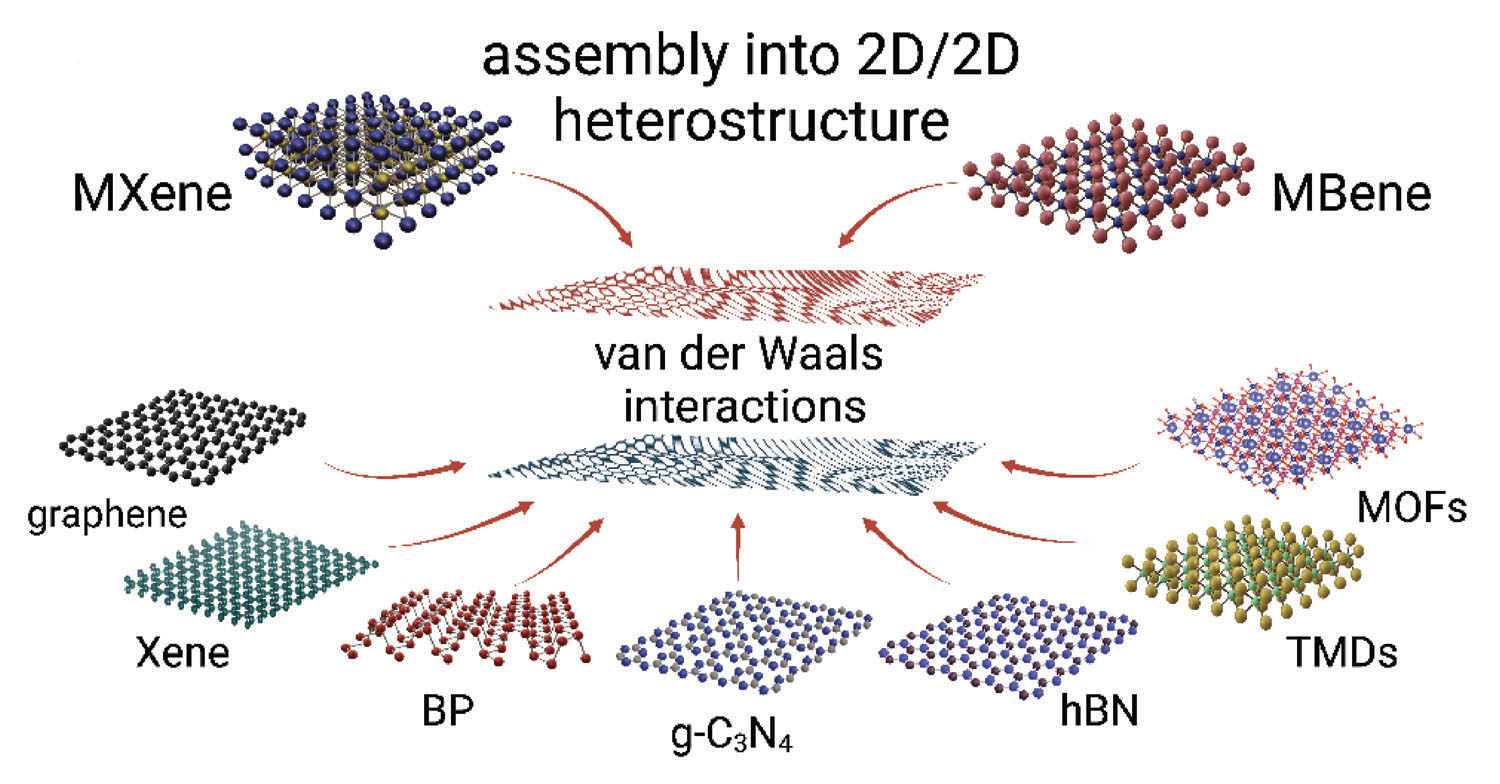| Oct 02, 2023 | |
Exploring the optoelectronic capabilities of MXene and MBene heterostructures |
|
| (Nanowerk Spotlight) Two-dimensional (2D) nanomaterials known as MXenes are emerging as exceptionally versatile building blocks for engineering next-generation optoelectronics and light-driven technologies. Closely related to MXenes are a new class of materials called MBenes, which show similarly promising properties. These layered materials composed of early transition metals and carbon/nitrogen/boron have highly tunable characteristics that make them promising candidates for tailored light absorption, emission, and manipulation. However, unlocking their full potential requires precise control over their intrinsic optical characteristics and electronic structure. | |
| In a Perspective published in Advanced Materials ("Optically Active MXenes in Van der Waals Heterostructures"), researchers highlight progress in assembling MXenes and MBenes with complementary 2D materials into vertical stacks called van der Waals (vdW) heterostructures. Bringing distinct 2D materials in close contact allows tuning of their properties at the interface, including optical and electronic behaviors. The layers are bound together by weak vdW forces, overcoming the need for lattice matching. | |
 |
|
| Schematic diagram of the optical properties of MXenes and MBenes compared to other 2D materials. (Reprinted with permission by Wiley-VCH Verlag) | |
| MXenes were first reported in 2011, but have seen surging research interest in the past decade, with over 30 compositions now made experimentally and more than 100 predicted computationally. MBenes are at an earlier stage of research, with only a handful of experimentally produced compositions so far. | |
| By altering their surface terminations like oxygen, fluoride and hydroxyl groups, MXenes and MBenes can exhibit metallic, semiconducting or insulating properties, providing exceptional flexibility in modulating light-matter interactions. Theoretical work shows both classes of materials have tunable bandgaps spanning 0-3 eV and 0-1 eV, respectively. | |
| Additionally, MXenes possess excellent conductivity, hydrophilicity and solution processability, making them ideal building blocks for vdW heterostructures with precisely tailored functionality. However, experimental realization of many proposed MXene and MBene heterostructures is still in early stages. There remain gaps in understanding interfacial effects on light harvesting capabilities and charge transfer mechanisms. | |
| Nonetheless, the possible vdW configurations using MXenes and MBenes span a wide range of 2D materials. For instance, graphene-based materials like graphene oxide (GO) enable straightforward water-based processing thanks to similar surface chemistries. Semiconducting black phosphorus can also be blended via solution, providing enhanced light absorption and tunable emission. | |
| Meanwhile, classes of 2D semiconductors like transition metal dichalcogenides (TMDCs) and insulating hexagonal boron nitride (hBN) are able to form type II heterojuctions with MXenes or MBenes. These junctions prolong the lifetime of photoexcited charges by promoting spatial charge separation. Additionally, 2D metal-organic frameworks (MOFs) layered with MXenes or MBenes can impart optical functionality and prevent restacking. | |
| The potential applications for these futuristic heterostructures are far-ranging, spanning photodetectors, LEDs, solar cells, optical sensors and photocatalysts. For example, MXene/black phosphorus assemblies have exhibited ultrafast nonlinear light absorption useful for optical switches. MXene/g-C3N4 heterostructures show improved visible light photocatalytic activity for applications like hydrogen production. MXenes themselves demonstrate near 100% light-to-heat conversion, creating robust photothermal agents. | |
| Additionally, the tunable work function and plasmonic properties of MXenes allow engineering Schottky junctions and hot carrier generation when interfaced with semiconductors. This has enabled high performance photodetectors and enhanced charge separation in solar cells. MBenes have also shown early promise for surface enhanced Raman spectroscopy applications. | |
 |
|
| Possible combinations for vertical vdW heterostructure assemblies based on MXenes or MBenes formed by vdW forces or assisted by covalent bonding. Secondary 2D materials to be combined with MXenes/MBenes can be chosen from the graphene or Xene family, graphitic carbon nitride (g-C3N4), hexagonal boron nitride (h-BN), transition metal dichalcogenides (TMDCs), or metal–organic frameworks (MOFs). (Reprinted with permission by Wiley-VCH Verlag) | |
| While research interest is rapidly accelerating, practical applications require better control over MXenes' and MBenes' surface terminations and tendency to oxidize. The vast compositional space also poses challenges for selecting optimal candidates and 2D counterparts. However, the remarkable versatility of these 2D material families provides almost limitless potential for designing vdW heterostructures with tailored optical and electronic properties. Precise stacking of distinct 2D layers with thickness of just a few nanometers facilitates engineering of exotic light-driven phenomena. | |
| Advanced processing techniques like chemical vapor deposition may someday enable large-scale manufacturing of MXene and MBene heterostructures for commercial optoelectronic devices. But further research is needed to fully understand these novel metamaterials and unlock their futuristic potential. Still, the future looks bright for moving these 2D material assemblies from lab concepts to real-world technologies that can manipulate light like never before. | |
 By
Michael
Berger
– Michael is author of three books by the Royal Society of Chemistry:
Nano-Society: Pushing the Boundaries of Technology,
Nanotechnology: The Future is Tiny, and
Nanoengineering: The Skills and Tools Making Technology Invisible
Copyright ©
Nanowerk LLC
By
Michael
Berger
– Michael is author of three books by the Royal Society of Chemistry:
Nano-Society: Pushing the Boundaries of Technology,
Nanotechnology: The Future is Tiny, and
Nanoengineering: The Skills and Tools Making Technology Invisible
Copyright ©
Nanowerk LLC
|
|
|
Become a Spotlight guest author! Join our large and growing group of guest contributors. Have you just published a scientific paper or have other exciting developments to share with the nanotechnology community? Here is how to publish on nanowerk.com. |
|
